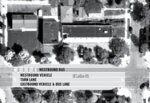

In a case of good intentions backfiring, Hennepin County has planned a B Line express bus route that will crawl along Lake Street at the pace of stalled traffic. This will result from its lane reconfiguration that was planned without consulting those who live and work along this busy county road.
People generally like the idea of faster bus service. I have used the A-Line on Snelling Avenue in St. Paul to hasten my trips to the state fair; I think it works well. Snelling has two lanes of traffic in each direction, so cars can pass buses that are, after all, designed to stop for passengers even when the light is green.
Hennepin County will have none of that nonsense. Eastbound, the county plans just one lane of through traffic. When the bus stops at a green light, the cars behind it will stop at a green light. Worse than that, the design has most bus stops on the far corner of the stoplight, with the bus stopping in the only lane of traffic. When a bus goes through a green light and stops, cars behind the bus will stop in the intersection on a green light. When that light turns red, the cars cannot budge because there is but one lane of traffic and a bus is blocking it. So, the cross traffic also cannot move.
If you think that this configuration is bad for cars but good for buses, you are half right. It’s bad for buses, too. Consider Lake Street at the River Road. Eastbound traffic backs up one or two blocks at each red light. That’s in two lanes. If you crowd all that traffic into one lane, that doubles the length of the backup. That’s bad for all vehicles that will wait several lights to make it through the intersection – including the buses stuck in that traffic. A single lane to accommodate both buses and cars does not accommodate either.
All of the above discussion assumes that a single lane exists, but we in Longfellow know that for five months every winter we lose the right lane of eastbound traffic. The parked cars obstruct that lane, and the snow is not even cleared from the lane at several intersections. Cars that currently shift to the inner lane to avoid parked cars and mounded snow in winter (and bicycles in summer) will have no place to go.
In the planning for reconstruction 18 years ago, a vocal few wanted to restrict Lake Street to one lane in each direction. Longfellow businesses objected. Hennepin County noted that the state requires four lanes if traffic exceeds 15,000 average daily trips (ADT), and Lake Street exceeded that at Snelling Avenue (20,300) and the river (17,000) and was close at 37th-38th Avenue (12,800, projected then to exceed 15,000 in 2016). In the reconstruction, all four lanes were retained, but the businesses compromised significantly elsewhere by agreeing to construct and maintain enhanced lighting, decorative fencing, trash containers, and benches. It transformed Lake and made it an attractive street. The businesses paid hundreds of thousands of dollars for those enhancements on top of their normal taxes and the steep assessments for the roadway. They still pay an extra $80,000 annually to maintain these improvements. Getting business support for these assessments was not easy and would not have been possible if Lake Street had been rebuilt with only two lanes.
Perhaps you think that this is not your problem because you live blocks from Lake Street. It will soon become your problem.Even now, driving on 28th or 32nd Street to the river and then to the Lake Street Bridge can save time when eastbound traffic on Lake is backed up. When that backup doubles in one lane, you can expect traffic on other east-west streets to increase.
The long lines mean gaps in traffic will occur only at stoplights, and then only when Lake Street traffic is not idling in the intersection behind a stopped bus. Elsewhere, nobody will be able to turn left onto Lake or cross Lake on foot or by car.
How was this plan developed? Not in consultation with property owners; I received no notice and learned about the plan from a fellow property owner on Lake Street who received a map shortly before the official groundbreaking on May 8. And not in consultation with the local business community; I am on the board of the Longfellow Business Association (LBA), which was never asked for input. I would have expected county representatives to reach out and (1) inform property owners that they plan to restrict traffic to one lane; and (2) explain why they think one lane will suffice when their position when Lake Street was rebuilt was directly contrary.
As bad as Hennepin County’s process was, the resulting plan is worse. The county should scrap its plan to abandon the current configuration of two lanes in each direction. Two lanes allow cars to pass stopped buses and prevent long backups of traffic that will ultimately slow all vehicles – including buses.
Dan Kennedy serves on the boards of the Longfellow Business Association and East Lake Special Services District, and served on the Hennepin County Project Advisory Committee when Lake Street was rebuilt. He is an attorney with Kennedy & Cain PLLC on East Lake Street, and this column reflects his personal perspective.
Comments
No comments on this item Please log in to comment by clicking here